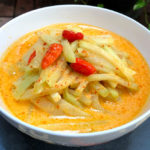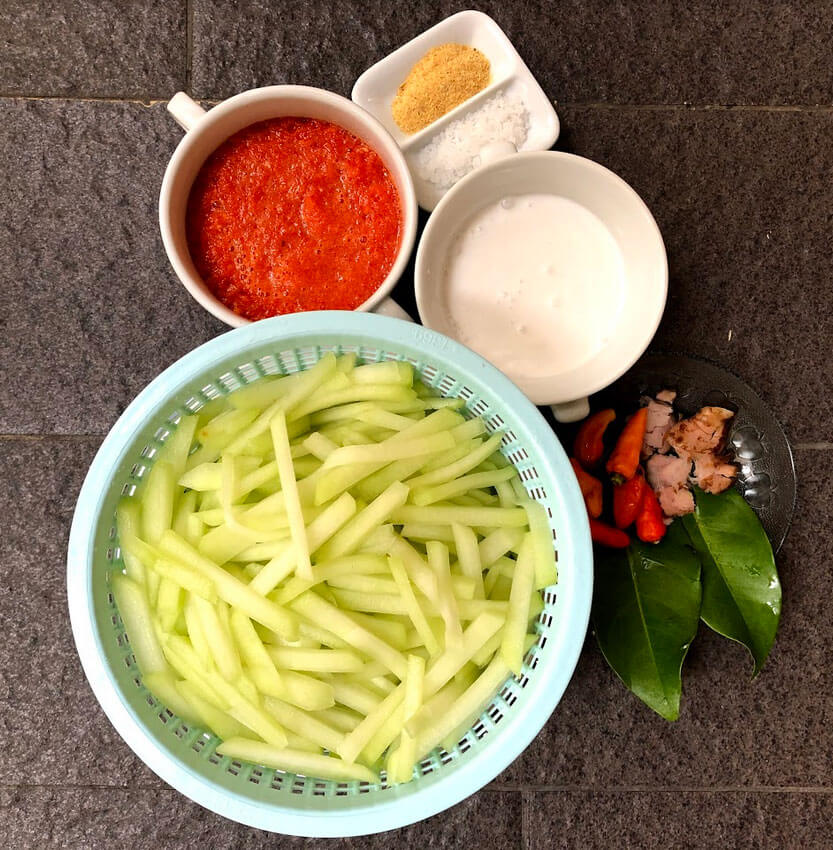Chayote, or labu siam in Indonesian, belongs to the gourd family (in Indonesian: labu-labuan). This vegetable was brought to Indonesia by the Dutch, who discovered it in Siam (the old name for Thailand, before 1939). Hence, we Indonesians call it labu siam, or “gourd from Siam”.
Labu siam is a climbing plant that grows easily in tropical countries, provided there is enough space. In Indonesia, people harvest the fruit and the young leaves. The young, tender fruits are usually eaten as lalapan (raw, steamed or boiled vegetables, unseasoned and eaten with sambal) and the bigger fruits are used for cooking, mostly in soups or in coconut milk broths. The young leaves are stir fried or cooked in soups such as bobor.
The recipe below is often paired with nasi liwet (a rice dish cooked in coconut milk, broth and spices) or ketupat (rice dumpling cooked in a pouch made of woven young coconut leaves, served during Eid). Ideal for both special occasions and everyday meals, you can always enjoy sambal goreng labu siam with a bowl of steamed rice and kerupuk (prawn crackers) to make your day feel special!
Print
Sambal Goreng Labu Siam: Chayote in Coconut Sambal Gravy
- Prep Time: 40 minutes
- Cook Time: 30 minutes
- Total Time: 70 minutes
- Yield: 4 1x
- Category: Vegetables
- Method: Boiling
- Cuisine: Indonesian
- Diet: Gluten Free
Description
Chayote is cooked in a coconut gravy using fried chilli paste as its base, to form a thick, spicy Southeast Asian curry. This recipe can easily be made vegetarian by omitting the optional dried shrimp.
Ingredients
- 2 chayotes (labu siam)
- 2 big red chillies, chopped
- 8 shallots, peeled and chopped
- 4 cloves garlic, peeled, and chopped
- 1 tsp dried shrimp. Soak in warm water for 5 minutes, then drain. (Optional)
- 2 cm galangal, bruised
- 2 salam leaves
- 0.5 tsp sugar
- Salt to taste
- 5 whole bird eye’s chillies (Optional)
- 3 tbsp vegetable oil
- 400 ml coconut milk
- 1 cup water
Instructions
- Cut the chayotes in half and rub the two halves against each other until the white thick sap comes out. Remove the sap. Peel and julienne the two halves into thin strips. Place the julienned chayotes in a colander, sprinkle with 1 tsp salt, set aside.
- Using a blender or food processor, blend into smooth paste the big red chillies, garlic, shallots and the dried shrimp.
- Wash the chayotes thoroughly, removing all the excess salt, and drain.
- Heat the vegetable oil in a wok over high heat, then sautee the blended spices, galangal and salam leaves until fragrant, around 2 minutes.
- Add salt and sugar.
- Add the chayotes and whole bird eye’s chillies, stir-fry for about 1 minute.
- Add water and coconut milk, stir, and reduce the heat to medium low.
- When it gently boils, continue cooking for around 7 minutes. Adjust the seasoning.
- The vegetable is ready when it is soft, but not falling apart.
- Turn off the heat and transfer the dish to a serving bowl.
Notes
For extra protein, you can add tofu, tempeh or quail eggs. These ingredients should be added between Steps 5 and 6 of the recipe.
Keywords: Vegetables, Chayote, Sambal Goreng, Spicy






An amazing recipe! I added fried tofu to the sambel goreng. Very nice. Even though I did not have daun Salam leaves, the taste was rich yet not too spicy.
★★★★★
Thank you for your review. Yes it can be a bit tough to get Daun Salam leaves outside Southeast Asia or especially Indonesia. The taste overall is wonderful regardless.
I just made them ,recipe easy to follow and taste so delicious
Thank you for your review Isabella! Glad you enjoyed the recipe!
It’s very tasty, thank you for the recipe
It’s tasty and it’s not hard to make once i gathered all the ingredients
★★★★★
Thank you for the vote of confidence Jane! Glad you enjoyed it!